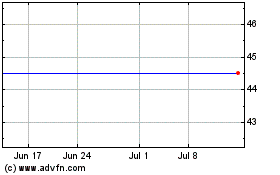Volkswagen alliance on heavy-duty trucks aims to challenge
Daimler's Freightliner
By William Boston and Bob Tita
Volkswagen AG's new development alliance with Navistar
International Corp. fuels the German company's ambition to chase
rival Daimler AG into the about $30 billion a year North American
heavy-duty truck market.
Volkswagen's shares of such truck sales are larger in Europe and
Latin America and it has a joint venture with Sinotruk (Hong Kong)
Ltd. in China. But Daimler entered the U.S. long ago, and has built
a business that now accounts for about 40% of U.S. heavy-duty truck
sales.
Volkswagen sought to even the score on Tuesday with its $256
million investment in Navistar, a 16.6% stake that will give it two
seats on the Lisle, Ill.-based truck maker's board. The stake and
related development-and-procurement alliance will broaden
Volkswagen's U.S. footprint and global truck-market operations.
Behind the intensifying rivalry are two executives who have
switched sides in the battle between the two German automotive
giants.
Andreas Renschler, chief executive of Volkswagen's Trucks and
Buses business, was the architect of Daimler's U.S. strategy.
Passed over as chief executive, he left Daimler at the end of 2014
and was tapped by Volkswagen patriarch Ferdinand Piech to mold the
fragmented truck businesses into a global enterprise.
Mr. Renschler's former colleague and rival, Daimler Trucks Chief
Executive Wolfgang Bernhard, is benefiting from the business that
he built. But he wouldn't compare Volkswagen and Daimler's bids to
grow in North America.
"You can ask that question of somebody else in 10 years," he
said in an interview on Tuesday.
Mr. Bernhard knows Volkswagen well. A decade ago he ran
Volkswagen's namesake car brand, pursuing an aggressive strategy to
standardize components and streamline the business. At Daimler
Trucks, he has driven efforts to create common truck platforms and
develop new technology.
Messrs. Renschler and Bernhard are approaching the U.S. and
global truck business with similar strategies.
Both are trying to bring the German auto industry's obsession
with standardization and common vehicle platforms to a U.S. market
equally obsessed with freedom of choice.
"We're trying to do something that the passenger car guys
started already decades ago, what they call the platform strategy,"
Mr. Bernhard said. "You use components in one vehicle and try to
disperse that in your lineup as much as possible and by that you
create economies of scale."
Daimler owns truck maker Freightliner and engine supplier
Detroit Diesel that have put its North American operations far
ahead of Navistar. The parent company of Mercedes-Benz has quietly
amassed 40% of heavy duty truck sales in North America in recent
years.
Detroit Diesel builds engines that are standardized enough to
keep development costs down even while producing versions of the
same engine for the U.S., European and Japanese markets.
"These are the beginnings of a platform strategy. Now we are
rolling it out to transmissions, we are rolling it out to axles and
we are rolling it out to medium duty engines," he said.
Creating a global truck platform that can allow Volkswagen to
share components across many different brands and models was a big
driver of this week's Navistar deal.
Volkswagen's investment in Navistar, at $15.76 a share,
represents a 12% premium to Friday's closing price. The two
companies expect regulatory approvals of the deal by early next
year.
Navistar anticipates cost savings of $500 million within the
first five years of the venture and annual savings of $200 million
after that. Initially, those savings were expected to come in the
form of cheaper raw materials and commodity components through
Navistar's wide-ranging procurement alliance with Volkswagen.
Navistar CEO Troy Clarke said the alliance provides Navistar
access to engine technology that should help it reclaim share lost
to competitors a few years ago due to engine reliability problems.
Navistar has about 11% of heavy-duty truck sales in North America,
down about half from five years ago.
"We want to get as much of that market as we can," Mr. Clarke
said on Tuesday. The alliance "will increase [customer]
consideration of our products."
Volkswagen's investment also provides a measure of stability for
cash-strapped Navistar, which has battled worries from customers
and investors that it would run out money.
"It gives some of their customers a sigh of relief to know that
[Navistar] is going to be around for the long haul," said Eric
Starks, CEO of transportation consultancy FTR in Indiana.
The deal, details of which were first reported on Monday by The
Wall Street Journal, comes as Navistar deals with the fallout from
a run-in over emissions regulations and a declining market share
that has left it trailing rivals in a North American commercial
truck market wrestling with a slump.
The bulk of potential savings from the venture aren't expected
to be realized until after 2019, when Volkswagen plans to launch a
new global platform for its heavy-truck brands MAN and Scania and
that it will now jointly develop with Navistar.
Volkswagen's MAN unit took a restructuring charge of more than
EUR200 million last year as part of Mr. Renschler's push to boost
earnings and savings by more closely integrating the German truck
maker with VW's Swedish manufacturer Scania.
Development of the new truck platform is still in the early
stages and was one of the reasons why Volkswagen wanted to do the
Navistar deal now.
"We are working on common powertrain platforms with MAN and
Scania and now Navistar is part of it and can be there from day
one," said Volkswagen's Mr. Renschler. "We want to have a
powertrain-based platform that will be used around the world."
Write to William Boston at william.boston@wsj.com and Bob Tita
at robert.tita@wsj.com
(END) Dow Jones Newswires
September 07, 2016 02:48 ET (06:48 GMT)
Copyright (c) 2016 Dow Jones & Company, Inc.
Navistar (NYSE:NAV)
Historical Stock Chart
From Aug 2024 to Sep 2024

Navistar (NYSE:NAV)
Historical Stock Chart
From Sep 2023 to Sep 2024
